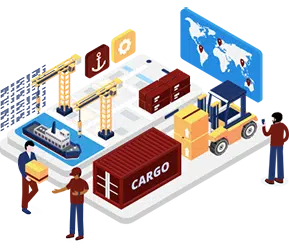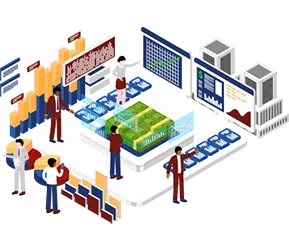Duty Drawback Trading Explained
Drawback Trading uses potential trading partners, identified by a third-party trading provider, to facilitate the exchange of goods between two unaffiliated companies with excess imports and exports to claim duty refunds using drawback. Specifically, imports and exports of the same HTSUS code.
How Does Drawback Trading Work?
We Identify Drawback Trading Relationships Between Importers and Exporters of the Same HTS
Step 1: Identify Trading Potential
A thorough analysis of your drawback trading potential will be completed to identify excess imports and exports not being claimed in an existing internal duty drawback program.
Step 2: Find A Trading Partner
Alliance will use your drawback trading analysis to carefully select potential trading partners with shared HTS level products by volume and project future potential to create a lasting trading relationship.
Step 3: Drawback Trading Model
Three drawback trading models will be discussed between the importer and exporter to determine the best method to maximize duty drawback recovery, minimize regulatory compliance exposure and maintain complete anonymity between the trading partners.
Step 4: Trade & Claim
After an MOU, SOP and shared recovery percentages are established, Alliance will facilitate the exchange of goods with the trading partners and act as a firewall to protect all sensitive and confidential data used in filing the drawback claim.
The Legal Language of Duty Drawback Trading
Toray Ruling
DRA-4-01 RR:CR:DR 230305RDC
Erik D. Smithweiss, Esq.
Grunfeld, Desiderio, Lebowitz, Silverman & Klestadt LLP
399 Park Avenue
25th Floor
New York, NY 10022-4877
RE: 19 USC § 1313(p); HRL 224420 (April 11, 1997); use of designated merchandise.
Dear Mr. Smithweiss:
This is in response to your letter dated January 5, 2004, with which you request, on behalf of your client, Toray International, Inc., (TI), and Toray Marketing & Sales America, Inc., (Tomac), a binding ruling per 19 C.F.R. § 177.2 regarding the applicability of 19 U.S.C. § 1313(p) to the facts described below.
FACTS:
TI, a Japanese company, is an exporter of finished petroleum derivatives. TI intends to enter into an arrangement with DL Trading, (DL), “for purposes of maximizing potential drawback recoveries on TI’s products imported into the United States.” DL was formed solely to maximize drawback and buys finished petroleum derivatives for import to and export from the United States.
The proposed transaction at issue is as follows. TI will sell finished petroleum derivatives to DL for import into the United States. The terms of sale will be “cost, insurance, freight (CIF) to Mitsui-Soko Warehouse in Atlanta, Georgia.” DL will import the derivatives from Japan into the United States and make entry. DL will be the importer of record in all cases and then will sell the imported derivatives to Tomac under the terms “FOB Mitsui-Soko Warehouse, Atlanta, Georgia.” Tomac is an American company and is an affiliate of TI. DL will sell the merchandise to Tomac “at a price that will cover DL’s costs for the goods and customs clearance related charges, plus 50 % of DL’s actual duty payments.” The reason for this pricing structure is stated to be that DL intends to claim drawback upon exportation of finished petroleum derivatives of the “same kind and quality” as those DL bought from TI.
The requestor states, “for purposes of this ruling request, it is [to be] assumed that the exporter of the ‘exported article’ satisfies the requirements of 19 U.S.C. § 1313(p)(2), and that DL will be a qualified ‘drawback claimant’ under 19 U.S.C. § 1313(p)(3)(C).” Finally, it is stated that the imported petroleum derivatives that DL will purchase from TI “‘will be qualified articles’ as defined in 19 C.F.R. § 191.172(a).”
The requestor poses the question, will the fact that DL was formed exclusively to maximize drawback benefits; or the fact that DL buys from and sells to related entities, i.e., TI and Tomac; or the fact that DL sells the qualified articles in the U.S. below cost because profit is expected to be made upon payment of the drawback claim, preclude DL from claiming drawback per § 1313(p)?
ISSUE:
Can DL Trading claim drawback per 19 U.S.C. § 1313(p) under the circumstances described on the petroleum derivatives it purchases from TI?
LAW AND ANALYSIS:
TI and DL intend to enter into an arrangement “for purposes of maximizing potential drawback recoveries on TI’s products imported into the United States.” DL was formed solely to maximize drawback and buys finished petroleum derivatives for import to and export from the United States. DL intends to claim drawback per 19 U.S.C. § 1313(p) upon exportation of finished petroleum derivatives of the “same kind and quality” as those DL bought from TI. In HRL 228946 (October 3, 2000,) we said that when a drawback applicant had satisfied the statutory conditions set forth, duty shall be refunded as drawback, in accordance with the unambiguous language of the statute. In that case, CBP considered whether the importation of duty-free pharmaceuticals, which were then returned immediately to the supplier for export in order to claim drawback on previously imported commercially interchangeable merchandise, would support a claim for drawback per 19 U.S.C. § 1313(j)(2).
Because we found the language of 19 U.S.C. § 1313(j)(2) “unambiguous,” we held in HRL 228946 that, “Congress has stated unambiguously that substitution permits a prior dutiable import to be designated against a subsequent duty-free import, so long as that foreign merchandise had been entered for consumption, and “that is the end of the matter.” Timex V.I. v. United States, 157 F.3d 879, 882 (Fed. Cir. 1998)). 19 U.S.C. § 1313(p) provides for drawback of the duties paid on certain petroleum derivatives. Under § 1313(p)(1), generally, notwithstanding any other provision in § 1313, if:
(A) an article [referred to in § 1313(p) as the “exported article”] of the same kind and quality [as specifically defined in section 1313(p)] as a qualified article is exported; (B) the requirements set forth in section 1313(p)(2) are met; and (C) a drawback claim is filed regarding the exported article,
drawback may be paid in accordance with the provisions of § 1313(p)(4) (19 U.S.C. § 1313(p)(1)). The “notwithstanding” clause was included in order to make the requirement in 19 U.S.C. §§ 1313(a) and (b), that the export article made by the petroleum refiner be the article that is actually exported, and the § 1313(j) requirement that the export article be commercially interchangeable with the imported article, inapplicable to claims under § 1313(p). .
Section 1313(p)(4) limits the amount of drawback payable under this section:
The amount of drawback payable under this subsection shall not exceed the amount of drawback that would be attributable to the article– (A) manufactured or produced under subsection (a) or (b) by the manufacturer or producer described in clause (i) or (ii) of paragraph (2)(A), or (B) imported under clause (iii) or (iv) of paragraph (2)(A) had the claim qualified for drawback under subsection (j).
(19 U.S.C. § 1313(p)(4)). Thus, in order for DL to claim drawback (per 1313(p)), the exported article must be of the “same kind and quality” per 1313(p)(3)(B) as the “qualified article” (per 1313(p)(3)(A)), and the requirements set forth in § 1313(p)(2) must be met; and a drawback claim must be filed.
“For purposes of this ruling request, it is [to be] assumed that DL will be a qualified ‘drawback claimant’ under 19 U.S.C. § 1313(p)(3)(C),” which provides:
The term “drawback claimant” means the exporter of the exported article or the refiner, producer, or importer of either the qualified article or the exported article. Any person eligible to file a drawback claim under this subparagraph may designate another person to file such claim.
Under 19 C.F.R. § 191.175(a), the “drawback claimant under 19 U.S.C. § 1313(p) must be the exporter of the exported article, or the refiner, producer, or importer of that article.” The regulations provide that any of these persons eligible to claim drawback may designate another person to file the drawback claim. Further, 19 C.F.R. § 191.82 provides that the exporter may waive the right to claim drawback and assign such right to the manufacturer, producer, importer or intermediate party.
It is stated that the imported petroleum derivatives that DL will purchase from TI and enter into the U.S., will be “qualified articles” as defined in 19 C.F.R. § 191.172(a). 19 C.F.R. § 191.172(a) states:
“Qualified article” means an article described in headings 2707, 2708, 2710 through 2715, 2901, 2902, 2909.19.14, or 3901 through 3914 of the Harmonized Tariff Schedule of the United States (HTSUS). In the case of an article described in headings 3901 through 3914, the definition covers the article in its primary forms as provided in Note 6 to chapter 39 of the HTSUS.
Per § 1313(p)(3)(A), inter alia,
The term “qualified article” means an article– (i) described in– (I) headings 2707, 2708, 2709.00, 2710, 2711, 2712, 2713, 2714, 2715, 2901, and 2902, and subheadings 2903.21.00, 2909.19.14, 2917.36, 2917.39.04, 2917.39.15, 2926.10.00, 3811.21.00, and 3811.90.00 of the Harmonized Tariff Schedule of the United States, . . . .
Nothing more is stated about the “qualified articles” that DL will purchase from TI import into the U.S.
After DL has entered the qualified articles this merchandise will then be sold to Tomac. Tomac is an affiliate of TI. DL will sell the merchandise to Tomac “at a price that will cover DL’s costs for the goods and customs clearance related charges, plus 50 % of DL’s actual duty payments.” The reason for this pricing structure is stated to be that DL intends to claim drawback upon exportation of finished petroleum derivatives of the “same kind and quality” as those DL bought from TI. The payment of drawback per § 1313(p) to DL is also contingent on the exported article meeting the definition of “same kind and quality “as the qualified article contained in § 1313(p)(3)(B):
An article, including an imported, manufactured, substituted, or exported article, is of the same kind and quality as the qualified article for which it is substituted under this subsection if it is a product that is commercially interchangeable with or referred to under the same eight-digit classification of the Harmonized Tariff Schedule of the United States as the qualified article. If an article is referred to under the same eight-digit classification of the Harmonized Tariff Schedule of the United States as the qualified article on January 1, 2000, then whether or not the article has been reclassified under another eight-digit classification after January 1, 2000, the article shall be deemed to be an article that is referred to under the same eight-digit classification of such Schedule as the qualified article for purposes of the preceding sentence.
Nothing further is stated about the exported articles that will be the basis of DL’s claim for drawback.
In addition, it is unknown who will export the “same kind and quality” finished petroleum derivatives. “For purposes of this ruling request, it is [to be] assumed that the exporter of the ‘exported article’ satisfies the requirements of 19 U.S.C. § 1313(p)(2). The requirements in § 1313(p)(2), compliance with which is a condition precedent to drawback under § 1313(p), are that the exporter must have: (1) manufactured a qualified article; or (2) purchased/exchanged the same from the manufacturer; or (3) imported a qualified article; or (4) purchased/exchanged a qualified article from the importer, all “in a quantity equal to or greater than the quantity of the exported article; and the exportation occurs within 180 days after the date of entry of an imported qualified article or during the manufacturing period or within 180 days after the close of such period.
As in HRL 228946, the language of § 1313(p) is unambiguous. Section 1313(p)(1) sets out the requirements briefly; the exported article and the qualified article must be of the same kind and quality, the requirements in 1313(p)(2) must be met and a drawback claim must be filed. If these requirements are met, “drawback shall be allowed . . . .” Thus, though under the facts described, the business relationships and transactions are expressly set up for the purpose of maximizing the drawback available under § 1313(p), provided that the all the statutory requirements in 19 U.S.C. §1313(p), including the filing a drawback claim and the applicable regulations, 19 C.F.R. Part 191, Subpart Q, are satisfied, DL would not be precluded from obtaining drawback.
HOLDING:
DL Trading can claim drawback per 19 U.S.C. § 1313(p) under the circumstances described on the petroleum derivatives it purchases from TI provided that all the statutory requirements are met and the applicable regulations are satisfied.
Sincerely,
Myles B. Harmon, Director
Commercial Rulings Division
“Customs Ruling HQ 230305”
https://www.customsmobile.com/rulings/docview?doc_id=230305&highlight=3811.21.00%2A
Evaluate Your Duty Drawback Trading Opportunity
No cost or obligation and easy to get started with Alliance. Identify new drawback program opportunity or evaluate the performance of your current program and maximize drawback refunds compliantly.




